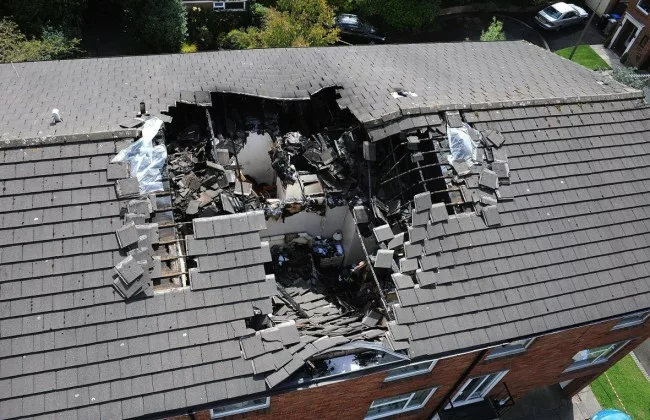Introduction
Preventing your property’s roof from collapsing is crucial to ensure the safety of your family and belongings. Regular maintenance and inspections can help identify potential issues before they become major problems. Here are some tips to prevent your property’s roof from collapsing.
Regular Roof Inspections and Maintenance
As a property owner, it is important to ensure that your roof is in good condition to prevent it from collapsing. Regular roof inspections and maintenance are crucial in preventing roof collapse. In this article, we will discuss the importance of regular roof inspections and maintenance and how they can help prevent your property’s roof from collapsing.
Regular roof inspections are essential in identifying any potential problems that may lead to roof collapse. During a roof inspection, a professional roofer will examine the roof for any signs of damage, such as cracks, leaks, or missing shingles. They will also check the condition of the roof’s structure, including the rafters, trusses, and beams. If any issues are identified, the roofer will recommend the necessary repairs to prevent further damage.
It is recommended that property owners have their roofs inspected at least once a year, preferably in the spring or fall. This is because these seasons are less likely to have extreme weather conditions that can cause damage to the roof. However, if your property is located in an area that experiences harsh weather conditions, such as heavy snow or strong winds, it is advisable to have your roof inspected more frequently.
In addition to regular inspections, proper maintenance is also crucial in preventing roof collapse. Maintenance includes tasks such as cleaning the gutters, removing debris from the roof, and trimming overhanging branches. These tasks help to prevent water from pooling on the roof, which can cause damage to the roof’s structure over time.
Cleaning the gutters is particularly important as clogged gutters can cause water to overflow onto the roof, leading to water damage and potential roof collapse. It is recommended that property owners clean their gutters at least twice a year, preferably in the spring and fall.
Removing debris from the roof is also important as it can trap moisture, which can cause damage to the roof’s structure. Debris can include leaves, branches, and other materials that have accumulated on the roof. It is recommended that property owners remove debris from their roofs as soon as possible to prevent any potential damage.
Trimming overhanging branches is also important in preventing roof collapse. Overhanging branches can cause damage to the roof’s structure during strong winds or heavy snow. It is recommended that property owners trim any overhanging branches that are within six feet of the roof.
In conclusion, regular roof inspections and maintenance are crucial in preventing roof collapse. Property owners should have their roofs inspected at least once a year and perform regular maintenance tasks such as cleaning the gutters, removing debris from the roof, and trimming overhanging branches. By taking these steps, property owners can ensure that their roofs are in good condition and prevent potential roof collapse.
Proper Snow and Ice Removal Techniques
As winter approaches, it is important to take the necessary precautions to prevent your property’s roof from collapsing due to the weight of snow and ice. The weight of snow and ice can put a significant amount of stress on your roof, which can lead to structural damage and even collapse. Therefore, it is essential to take the necessary steps to ensure that your roof can withstand the weight of snow and ice.
One of the most important steps in preventing your property’s roof from collapsing is proper snow and ice removal techniques. It is important to remove snow and ice from your roof as soon as possible to prevent the weight from building up and causing damage. However, it is equally important to use the proper techniques to avoid causing damage to your roof.
The first step in proper snow and ice removal is to use the right tools. Using a shovel or other sharp tools can damage your roof and cause leaks. Instead, use a roof rake or a broom with soft bristles to remove snow and ice. These tools are designed to remove snow and ice without damaging your roof.
When removing snow and ice, it is important to start at the edge of the roof and work your way towards the center. This will prevent the weight of the snow and ice from pushing against the edge of the roof and causing damage. Additionally, it is important to remove only a few inches of snow and ice at a time to prevent the weight from shifting and causing damage.
It is also important to avoid using salt or other chemicals to melt snow and ice on your roof. These chemicals can damage your roof and cause leaks. Instead, use a roof rake or broom to remove the snow and ice manually.
If you are unable to remove the snow and ice from your roof yourself, it is important to hire a professional. A professional will have the necessary tools and experience to safely remove the snow and ice from your roof without causing damage.
In addition to proper snow and ice removal techniques, it is important to ensure that your roof is properly maintained. Regular inspections and maintenance can help identify any potential issues before they become a problem. Additionally, it is important to ensure that your roof is properly insulated to prevent heat loss, which can cause snow and ice to melt and refreeze, adding additional weight to your roof.
In conclusion, proper snow and ice removal techniques are essential in preventing your property’s roof from collapsing. Using the right tools, starting at the edge of the roof, removing only a few inches of snow and ice at a time, and avoiding the use of chemicals are all important steps in proper snow and ice removal. Additionally, regular inspections and maintenance, as well as proper insulation, can help ensure that your roof can withstand the weight of snow and ice. By taking these steps, you can help prevent damage to your property and ensure the safety of those inside.
Reinforcing the Roof Structure with Additional Support Systems
As a property owner, one of the most important things you need to consider is the safety and stability of your building’s roof. A roof collapse can be a catastrophic event that can cause significant damage to your property and put the safety of your occupants at risk. Fortunately, there are several ways to prevent your property’s roof from collapsing, and one of the most effective methods is to reinforce the roof structure with additional support systems.
Roof reinforcement is the process of adding extra support to your roof to increase its load-bearing capacity and prevent it from collapsing under heavy snow, rain, or wind. There are several types of support systems that you can use to reinforce your roof, including trusses, beams, and columns.
Trusses are triangular structures that are used to support the roof and distribute its weight evenly across the building’s walls. They are typically made of wood or steel and can be installed either during the construction of a new building or as a retrofit to an existing one. Trusses are an excellent choice for reinforcing roofs because they are lightweight, easy to install, and can be customized to fit any roof design.
Beams are horizontal support structures that are used to distribute the weight of the roof across the building’s walls. They are typically made of wood or steel and can be installed either above or below the roof. Beams are an excellent choice for reinforcing roofs because they are strong, durable, and can be customized to fit any roof design.
Columns are vertical support structures that are used to transfer the weight of the roof to the building’s foundation. They are typically made of steel or concrete and can be installed either inside or outside the building. Columns are an excellent choice for reinforcing roofs because they are strong, durable, and can be customized to fit any roof design.
When choosing a support system for your roof, it is essential to consider several factors, including the type of roof, the size of the building, and the local weather conditions. For example, if you live in an area that experiences heavy snowfall, you may need to install a support system that can withstand the weight of the snow.
In addition to reinforcing your roof with additional support systems, there are several other steps you can take to prevent your property’s roof from collapsing. These include:
1. Regular roof inspections: Regular roof inspections can help you identify any potential issues with your roof before they become a problem. A professional roofing contractor can inspect your roof and recommend any necessary repairs or reinforcements.
2. Proper maintenance: Proper maintenance, such as cleaning gutters and removing debris from the roof, can help prevent damage to your roof and extend its lifespan.
3. Snow removal: If you live in an area that experiences heavy snowfall, it is essential to remove snow from your roof regularly. Snow can add significant weight to your roof and increase the risk of collapse.
4. Professional installation: When installing a new roof or adding support systems, it is essential to hire a professional roofing contractor. A professional contractor can ensure that the installation is done correctly and that your roof is safe and stable.
In conclusion, reinforcing your property’s roof with additional support systems is an effective way to prevent roof collapse and ensure the safety of your occupants. When choosing a support system, it is essential to consider several factors, including the type of roof, the size of the building, and the local weather conditions. In addition to reinforcement, regular inspections, proper maintenance, snow removal, and professional installation can help prevent roof collapse and extend the lifespan of your roof.
Conclusion
To prevent your property’s roof from collapsing, it is important to regularly inspect and maintain the roof. This includes checking for any signs of damage or wear, such as cracks, leaks, or missing shingles, and repairing them promptly. It is also important to ensure that the roof is properly ventilated and insulated to prevent ice dams and excessive weight from accumulating. Additionally, removing snow and debris from the roof can help prevent collapse. Overall, taking proactive measures to maintain the roof can help ensure the safety and longevity of your property.



